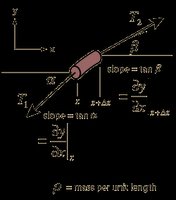 We all encounter it some time or another.
We all encounter it some time or another. Show that if statement A is true, then statement D is true. Upon diagnosing the patient, one may choose to make a direct proof. That is, assume A and work towards B. In symbols:
A→D
Let A be true. (lots of work). D. Therefore, A→D.
Unfortunately, D can sometimes be very hard to see. It is for this reason that the forward backward method is useful. Before assuming the left hand side (A), one should analyze D. Is there some statement C such that C→D? Then is there some statement B such that B→C? Now we need only show A→B, then by default A→D since D→C→B.
One should first work backwords towards A, then assume A to be true and prove the last statement from the backwards method.
Consider the following
example:
Show that If right triangle XYZ with sides of length x, y, and hypotenuse z has an area of z^2/4, then triangle XYZ is isosceles.
It is very tempting to just assume the left hand side, but lets try working backwards first. What does it mean for a triangle to be isosceles? Ah, thats right, it means that the triangle has two sides of equal length. So if we were to show that x=y, then triangle XYZ would be isosceles.
Now lets try to step backwards again. what does it mean for two numbers to be equal? Not much. As you can see, things start getting trivial. Lets stop here and start working forwards to show x=y.
Assume the left side. That is assume the triangle has area z^2/4. Well, we know that the area of a triangle is A=(1/2)base*height. This yields (1/2)x*y = z^2/4, since A=z^2/4 by the problem definition. Remember, we want to show that x=y, but we have a nasty z in the way. Since this is a right triangle, we can get rid of it with the Pythagorean Theorem. since x^2+y^2=z^2, we can replace z^2. Now, we have (1/2)xy=(x^2+y^2)/4. Algebra shows that this is really a simple quadratic: x^2 + 2xy + y^2 = 0. Factoring, (x-y)^2=0, and so x-y=0. Subtracting the y reveals that x=y, which is the last step in our backwards process, meaning that we are done.
Remember, try to work backwards a bit before you assume the left hand side and work forwards in a direct proof. Sometimes the backwards steps will act as a blueprint to the direct proof.
 The e-mail arrived today. I am going to be invited to be a research assistant at MTSU this summer. The goal: break the speed of light through sound pulses. As long as the Einstein police don't pull me over, this will be great.
The e-mail arrived today. I am going to be invited to be a research assistant at MTSU this summer. The goal: break the speed of light through sound pulses. As long as the Einstein police don't pull me over, this will be great.



